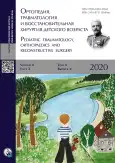Плоскостопие или нет: субъективное восприятие высоты свода стоп среди врачей-ортопедов
- Авторы: Димитриева А.Ю.1, Кенис В.М.2, Сапоговский А.В.2
-
Учреждения:
- ФГБОУ ВО «Северо-Западный государственный медицинский университет им. И.И. Мечникова» Минздрава России
- ФГБУ «Научно-исследовательский детский ортопедический институт им. Г.И. Турнера» Минздрава России
- Выпуск: Том 8, № 2 (2020)
- Страницы: 179-184
- Раздел: Оригинальные исследования
- URL: https://bakhtiniada.ru/turner/article/view/21192
- DOI: https://doi.org/10.17816/PTORS21192
- ID: 21192
Цитировать
Аннотация
Обоснование. Визуальный метод диагностики плоскостопия является наиболее распространенным в практике детских ортопедов. Для обоснования его использования в качестве стандартного необходимо подтвердить достаточную согласованность специалистов.
Цель — определить согласованность в восприятии высоты свода при визуальной диагностике плоскостопия у детей.
Материалы и методы. На первом этапе были обследованы 187 детей (374 стопы) младшего школьного возраста. Все дети были осмотрены и всем была выполнена компьютерная плантография. Для проведения второго этапа исследования случайным образом были отобраны 130 изображений правой стопы в стандартных проекциях — медиальной боковой и задней, которые были предоставлены в электронном виде 32 врачам-ортопедам (десять из которых составили эксперты — врачи, специализирующиеся на патологии стоп). Специалистам необходимо было отметить, является ли стопа, представленная для анализа, плоской. Для определения межэкспертной согласованности использовали коэффициенты конкордантности w-Кендалла и корреляции τ-Кендалла, а спустя 5 мес. рассчитывали коэффициент κ-Коэна.
Результаты. Исходя из результатов нашего исследования, показатели межэкспертной и внутриэкспертной надежности значительно отличаются в зависимости от того, специализируется ортопед на патологии стоп или нет. При расчете коэффициента конкордантности степень согласованности среди экспертов увеличилась спустя 5 мес. (0,58 и 0,76 соответственно) в отличие от ортопедов, не специализирующихся на патологии стоп. Несмотря на то что во мнениях экспертов по одной и той же стопе была отмечена некоторая разнородность, общий коэффициент корреляции соответствовал хорошему и отличному уровню согласованности (0,65–0,84). Коэффициент κ-Коэна для оценки параметров устойчивости визуальных критериев диагностики плоскостопия среди специалистов соответствовал хорошему уровню надежности (0,72), в то время как среди ортопедов, не специализирующихся на патологии стоп, — низкому (0,31). При оценке изображений одних и тех же стоп согласно экспертам частота плоскостопия составила 24,6 %, в то время как согласно ортопедам, не специализирующимся на патологии стоп, — 40,9 %.
Заключение. Ответы экспертов в отношении того, какую стопу считать плоской, продемонстрировали хороший и отличный уровни согласованности, что может быть использовано для определения референтных значений антропометрических показателей медиального продольного свода.
Полный текст
Открыть статью на сайте журналаОб авторах
Алёна Юрьевна Димитриева
ФГБОУ ВО «Северо-Западный государственный медицинский университет им. И.И. Мечникова» Минздрава России
Автор, ответственный за переписку.
Email: aloyna17@mail.ru
ORCID iD: 0000-0002-3610-7788
SPIN-код: 7112-8638
Scopus Author ID: 1026726
очный аспирант кафедры детской травматологии и ортопедии
Россия, 195015, г. Санкт-Петербург, Кирочная ул., 41Владимир Маркович Кенис
ФГБУ «Научно-исследовательский детский ортопедический институт им. Г.И. Турнера» Минздрава России
Email: kenis@mail.ru
ORCID iD: 0000-0002-7651-8485
SPIN-код: 5597-8832
Scopus Author ID: 36191914200
http://www.rosturner.ru/kl4.htm
д-р мед. наук, профессор, заместитель директора по развитию и внешним связям, руководитель отделения патологии стопы, нейроортопедии и системных заболеваний
Россия, 196603, г. Санкт-Петербург, г. Пушкин, ул. Парковая, дом 64-68Андрей Викторович Сапоговский
ФГБУ «Научно-исследовательский детский ортопедический институт им. Г.И. Турнера» Минздрава России
Email: sapogovskiy@gmail.com
ORCID iD: 0000-0002-5762-4477
SPIN-код: 2068-2102
Scopus Author ID: 808611
канд. мед. наук, старший научный сотрудник отделения патологии стопы, нейроортопедии и системных заболеваний ФГБУ «НИДОИ им. Г.И. Турнера»
Россия, 196603, г. Санкт-Петербург, г. Пушкин, ул. Парковая, дом 64-68Список литературы
- Большая медицинская энциклопедия. Т. 19 / под ред. Б.В. Петровского. – 3-е изд. – М.: Советская энциклопедия, 1989. [Bol’shaya meditsinskaya entsiklopediya. Izdanie tret’e. Vol. 19. Ed. by B.V. Petrovskiy. Moscow: Sovetskaya entsiklopediya; 1989. (In Russ.)]
- Chuckpaiwong B, Nunley JA, 2nd, Queen RM. Correlation between static foot type measurements and clinical assessments. Foot Ankle Int. 2009;30(3):205-212. https://doi.org/10.3113/FAI.2009.0205.
- Hosl M, Bohm H, Multerer C, Doderlein L. Does excessive flatfoot deformity affect function? A comparison between symptomatic and asymptomatic flatfeet using the Oxford Foot Model. Gait Posture. 2014;39(1):23-28. https://doi.org/10.1016/j.gaitpost.2013.05.017.
- Houck JR, Tome JM, Nawoczenski DA. Subtalar neutral position as an offset for a kinematic model of the foot during walking. Gait Posture. 2008;28(1):29-37. https://doi.org/10.1016/j.gaitpost.2007.09.008.
- Армасов А.Р., Киселев В.Я. Диагностическая ценность метода визуальной оценки стоп при диагностике плоскостопия у подростков // Гений ортопедии. – 2010. – № 3. – С. 101–104. [Armasov AR, Kiselev VY. Diagnostic value of the technique for feet visual estimation in adolescent platypodia determination. Genij ortopedii. 2010;(3):101-104. (In Russ.)]
- Dahle LK, Mueller MJ, Delitto A, Diamond JE. Visual assessment of foot type and relationship of foot type to lower extremity injury. J Orthop Sports Phys Ther. 1991;14(2): 70-74. https://doi.org/10.2519/jospt.1991.14.2.70.
- Cowan DN, Robinson JR, Jones BH, et al. Consistency of visual assessments of arch height among clinicians. Foot Ankle Int. 1994;15(4):213-217. https://doi.org/10.1177/107110079401500411.
- Redmond AC, Crosbie J, Ouvrier RA. Development and validation of a novel rating system for scoring standing foot posture: the Foot Posture Index. Clin Biomech (Bristol, Avon). 2006;21(1):89-98. https://doi.org/10.1016/j.clinbiomech.2005.08.002.
- Keenan AM, Redmond AC, Horton M, et al. The Foot Posture Index: Rasch analysis of a novel, foot-specific outcome measure. Arch Phys Med Rehabil. 2007;88(1):88-93. https://doi.org/10.1016/j.apmr.2006.10.005.
- Cain LE, Nicholson LL, Adams RD, Burns J. Foot morphology and foot/ankle injury in indoor football. J Sci Med Sport. 2007;10(5):311-319. https://doi.org/10.1016/j.jsams.2006.07.012.
- Evans AM, Rome K, Peet L. The foot posture index, ankle lunge test, Beighton scale and the lower limb assessment score in healthy children: a reliability study. J Foot Ankle Res. 2012;5(1):1. https://doi.org/10.1186/1757-1146-5-1.
- Evans AM, Copper AW, Scharfbillig RW, et al. Reliability of the foot posture index and traditional measures of foot position. J Am Podiatr Med Assoc. 2003;93(3):203-213. https://doi.org/10.7547/87507315-93-3-203.
- Mentiplay BF, Clark RA, Mullins A, et al. Reliability and validity of the Microsoft Kinect for evaluating static foot posture. J Foot Ankle Res. 2013;6(1):14. https://doi.org/10.1186/1757-1146-6-14.
- Landis JR, Koch GG. The measurement of observer agreement for categorical data. Biometrics. 1977;33(1):159-174. https://doi.org/10.2307/2529310.
Дополнительные файлы













